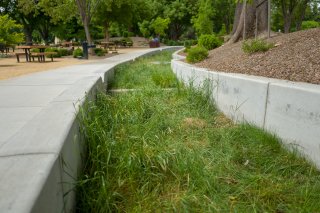Local Governments and Trees
Communities use a variety of approaches to increase trees and vegetation and reduce local heat island effects. Depending on local priorities, efforts may be led by different government agencies, including parks, public works, sustainability, environmental conservation, and/or utilities. Vegetation program and policy examples appear in the Heat Island Community Actions Database.
Strategic Planning
Strategic planning efforts guide how and where priority planting efforts occur within a community.
- Tree canopy assessments identify current vegetative cover using remote sensing, satellite imagery, existing land cover databases, or sampling methods to document the location, type, and size of trees. This process often detects areas of the community where tree cover is low and heat impacts are disproportionately felt.
-

- Comprehensive development and land use plans often prioritize the creation of parks, recreation areas, or conservation areas, which may increase tree cover in communities and reduce heat impacts.
- Sustainability and climate action plans may prioritize tree planting and related actions to lower greenhouse gas emissions or improve resilience to heat islands or natural hazards (e.g., heat waves).
Examples of strategic vegetation planning efforts include Philadelphia, Pennsylvania’s tree canopy assessment; Dallas, Texas’ urban forestry master plan; and Tempe, Arizona’s tree canopy coverage priority within in its climate action plan.
Nature-based solutions
Nature-based solutions seek to use trees to restore natural habitats or adapt to changing conditions.
- Planting programs rely on local governments and/or community partners to increase trees and vegetation in priority locations.
- Tree planting guides and approved species lists dictate vegetation options within a community using criteria such as non-invasiveness, water or maintenance needs, susceptibility to pests, size, and resilience to changing climate conditions or natural hazards.
An example of a community using nature-based solutions includes Baltimore, Maryland’s efforts to recruit volunteers to plant thousands of trees annually. Davis, California maintains a master tree list.
Zoning and Ordinances
Many communities enact mandatory measures to preserve or increase tree cover.
- Zoning may dictate minimum amounts of vegetive coverage and/or green infrastructure for stormwater retention or other community benefits. Requirements may vary by the property type or zone; for example, requirements for single-family homes may be different than for shopping centers.
- Ordinances allow communities to dictate in what circumstances trees are removed and what varieties are approved for replanting.
Community examples include Sommerville, Massachusetts’ zoning green score, and San Antonio, Texas’ tree preservation and landscape ordinances.
Financial Drivers
Financial incentives and penalties are common tools communities use to increase tree canopy, decrease energy use, and enhance stormwater retention.
- Incentives provide free resources or financial breaks when vegetation is used in certain circumstances; for example, offering free trees or discounting energy bills.

- Rebates offer credits or reimbursement for planting vegetation inline with community goals. For example, communities may reimburse a fixed amount for planting trees from approved species lists.
- Penalties are fees or fines for failing to meet vegetation requirements. Some communities impose fines for removing trees or assess higher stormwater fees based on impervious surfaces.
Communities using financial drivers include Los Angeles, California where the Los Angeles Department of Water and Power partners with the organization City Plants to offer residents frees trees, and Sacramento, California where the Sacramento Municipal Utility District partners with the Sacramento Tree Foundation to offer residents a rebate or reimbursement for shade trees.
More Information and Resources
More details are available in Chapter Two of EPA’s Reducing Urban Heat Islands: Compendium of Strategies, which covers the following topics:
- How trees and vegetation reduce temperatures
- The benefits and costs associated with trees and vegetation
- Other factors to consider when using trees and vegetation
- Urban forestry initiatives
- Tree and vegetation tools and resources
Greening and Forestry Resources For Local Governments
- U.S. EPA Green Infrastructure Program
- U.S. Forest Service Urban and Community Forest Program
- Arbor Day Foundation
- American Society of Landscape Architects
- American Forests

